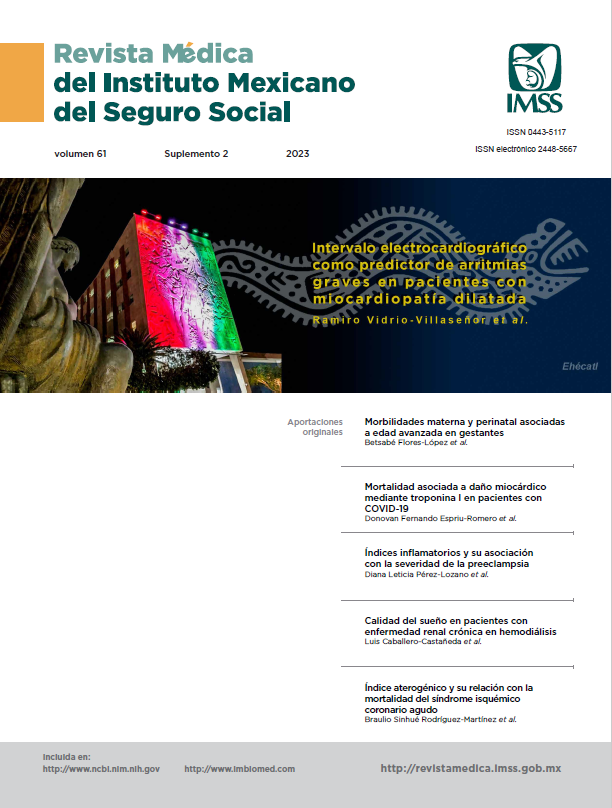Inflammatory indexes and their association with the severity of preeclampsia
Main Article Content
Keywords
Cross-Sectional Studies, Gynecology, Inflammation, Pregnancy, Pre-Eclampsia
Abstract
Background: Recent studies have confirmed the relationship between some inflammatory indexes and preeclampsia (PE); however, they have not been analyzed in PE with and without severity criteria. Objective: To know the association between inflammatory indexes and the severity of PE.
Material and methods: Analytical cross-sectional prolective study. Pregnant patients were included, divided into group 1 (PE without severity criteria); group 2 (PE with severity criteria); group 3 (normotensive pregnant women). Records were reviewed and inflammatory indexes [(neutrophil-lymphocyte ratio [NLR], platelet-lymphocyte ratio [PLR], lymphocyte-monocyte ratio [LMR] and systemic immune index [SII]) were calculated.
Results: 240 patients were analyzed, 80 per group; age 28 (IQR 27-29) years. A significant difference was observed between group 1, group 2 and group 3, NLR 3.29 (IQR 2.82- 3.69), 3.59 (IQR 2.83-4.2) and 3.42 (IQR 3.17-3.92), respectively, p = 0.02; PLR 121.59 (IQR 103.78-132), 108.32 (IQR 92.96-127.43) 136 (IQR 115.18-157.56), respectively, p = 0.01; LMR and SII showed no difference between the groups. LMR made possible to distinguish PE with and without severity criteria, cut-off point of ≥ 3.20, sensitivity 56%, specificity 56%, AUC 0.56, p = 0.01, and cut-off point ≥ 3.24, sensitivity 58%, specificity 58%, AUC 0.57, p = 0.04, respectively; the LMR ≥ 3.24 was associated with PE without severity criteria (OR 2.02 [95%CI 1.08-3.80], p = 0.03).
Conclusions: The MLR was the only inflammatory index analyzed that was associated with the presence of PE without severity data. No inflammatory index was associated with PE with severity data.
References
[No authors listed]. Gestational Hypertension and Preeclampsia: ACOG Practice Bulletin, Number 222. Obstet Gynecol 2020;135(6):e237-60. doi: 10.1097/AOG.0000000000003891.
Instituto Mexicano del Seguro Social. Prevención, diagnóstico y tratamiento de la Preeclampsia en segundo y tercer nivel de atención. Ciudad de México: IMSS; 16 de marzo de 2017.
Vázquez-Rodríguez JG, Sánchez-Brito LO. Severidad de la preeclampsia: datos de un hospital de alta especialidad en Ciudad de México. Rev Med Inst Mex Seguro Soc. 2020;58(2):444- 9. Disponible en: http://revistamedica.imss.gob.mx/editorial/ index.php/revista_medica/article/view/3348/4100.
Álvarez-Fernández I, Prieto B, Álvarez FV. Preeclampsia. Revista del Laboratorio Clínico. 2016;(2):81-9. doi: 10.1016/j. labcli.2016.04.002.
Rana S, Lemoine E, Granger J, Karumanchi SA. Preeclampsia. Circulation Research. 2019; 124(7):1094-112. doi: https:// doi.org/10.1161/CIRCRESAHA.118.313276.
Reyna-Villasmil E, Mejia-Montilla J, Reyna-Villasmil N, Torres-Cepeda D, Fernández-Ramírez A. Utilidad diagnóstica de la relación neutrófilos/linfocitos en embarazadas con preeclampsia. Rev Chil Obstet Ginecol. 2018;83(3)257-65. Disponible en: https://www.scielo.cl/pdf/rchog/v83n3/0048- 766X-rchog-83-03-0257.pdf.
Serin S, Avcı F, Ercan O, Köstü B, Bakacak M, Kıran H. Is neutrophil/lymphocyte ratio a useful marker to predict the severity of pre-eclampsia? Pregnancy Hypertens. 2016;6(1):22-5. doi: 10.1016/j.preghy.2016.01.005.
Hernández Restrepo F, Perilla Hernández N, Martínez Sánchez LM, Ruiz Mejía C. Biomarcadores moleculares: una nueva herramienta en el diagnóstico de la preeclampsia. Clin Invest Gin Obst. 2017;44(2):66-72. doi: 10.1016/j.gine.2016.04.001.
Yu S, Arima H, Bertmar C, Clarke S, Herkes G, Krause M. Neutrophil to lymphocyte ratio and early clinical outcomes in patients with acute ischemic stroke. J Neurol Sci. 2018;387: 115-8. doi: 10.1016/j.jns.2018.02.002.
Valga F, Monzón T, Henriquez F, Antón-Pérez G. Índices neutrófilo-linfocito y plaqueta-linfocito como marcadores biológicos de interés en la enfermedad renal. Nefrología. 2019; 39(3):243-9. doi: 10.1016/j.nefro.2018.11.005.
Zavala García A, Navarro Torres Arpi P, Padilla-Amigo C, Lara Barragan Bernal IA. Utilidad diagnóstica del biomarcador relación plaquetas-linfocitos en rotura prematura de membranas de término y pretérmino. Perinatología y Reproducción Humana. 2018;32(4):151-4. doi: https://doi.org/10.1016/j. rprh.2018.08.007.
Alonzo-García CJ, García-Jiménez ES, Martínez-Villaseñor E, Flores-Mendoza JF, Zaragoza-Scherman F, Briones-Govea D, et al. Índice Linfocito-Monocito y Neutrófilo-Linfocito como predictores de mortalidad e infección en pacientes hospitalizados con cirrosis hepática descompensados. Rev Med MD. 2019;9.10(2):84-88.
Lagunas-Alvarado M, Mijangos-Huesca FJ, Terán-González JO, Lagunas-Alvarado MG, Martínez-Zavala N, Reyes-Franco I, et al. Índice de inmunidad-inflamación sistémica en sepsis. Med Int Méx. 2017;33(3):303-9. Disponible en: https://www. scielo.org.mx/pdf/mim/v33n3/0186-4866-mim-33-03-00303.pdf.
Ochoa B. Índice Neutrófilos/Linfocitos en pacientes gestantes con preeclampsia del Hospital General de Latacunga, Ecuador. Archivos Venezolanos de Farmacología y Terapéutica. 2020;39(0798-0264):417-25. doi: https://doi.org/10.5281/ zenodo.4091968.
Taylor EB, Sasser JM. Natural killer cells and T lymphocytes in pregnancy and pre-eclampsia. Clin Sci. 2017;131(24):2911-7. doi: 10.1042/CS20171070.
Chimbo C, Mariño M, Chimbo T, Caicedo C. Factores de riesgo y predictores de preeclampsia: una mirada al futuro. Revista Latinoamericana de Hipertensión; 2018;13(1):6-12. Disponible en: https://www.revhipertension.com/rlh_1_2018/ factores_riesgo_predictores.pdf.
Ghelfi AM, Lassus MN, Diodati S, Hails EA. Utilidad del índice neutrófilo/linfocito y del índice polimorfonuclear/monomorfonuclear, en la predicción de preeclampsia. Hipertensión y Riesgo Vascular. 2019;36(2):63-9. doi: 10.1016/j. hipert.2018.06.001.
Prasmusinto D, Jono RC, Lisnawati Y. Neutrophil Lymphocyte Ratio and Red Cell Distribution Width as a Marker of Preeclampsia: A Retrospective Study. Journal of Pregnancy and Child Health. 2017;04(02). doi:10.4172/2376-127X.1000307.
Kithcart AP, Libby P. Unfriendly fire from neutrophils promiscuously potentiates cardiovascular inflammation. Circ Res. 2017;121(9):1029-31. doi: 10.1161/circresaha.117.311867.
Cortez A, Muxfeldt E. Monocyte chemoattractant protein-1 and hypertension: An overview. Hipertensión y Riesgo Vascular. 2022;39(1):14-23. doi: 10.1016/j.hipert.2021.11.003.
Prat H, Araos P, Michea L. La inflamación en la hipertensión arterial, mecanismos de producción e implicancias terapéuticas. Rev Med Chil. 2021;149(2):255-62. doi: 10.4067/ s0034-98872021000200255.
Rosas-Cabral A, Ruiz Esparza-Mota JA, Gutiérrez-Campos R, Torres-Cabral G, Robles-Martínez MC, Hernández-Muñoz M. Índice neutrófilo-linfocito, relación plaquetas-linfocito y distribución de la anchura del eritrocito en pacientes con preeclampsia. Ginecol Obstet Mex. 2022;90(6):504-12. doi: https://doi.org/10.24245/gom.v90i6.7473.
Rosas-Peralta M, Borrayo-Sánchez G, Madrid-Miller A, Ramírez-Arias E, Pérez-Rodríguez G. Hipertensión durante el embarazo: el reto continúa. Rev Med Inst Mex Seguro Soc. 2016;54 Supl 1:S90-111. Disponible en: http://revistamedica. imss.gob.mx/editorial/index.php/revista_medica/article/ view/426/915.
Viana-Rojas JA, Rosas-Cabral A, Prieto-Macías J, Terrones-Saldívar MC, Arcos-Noguez P, Bermúdez-Gómez J, et al. Severidad de la preeclampsia y su relacion con volumen plaquetario y ancho de distribucion eritrocitaria. Rev Med Inst Mex Seguro Soc. 2017;55(2):176-81. Disponible en: http://revistamedica.imss.gob.mx/editorial/index.php/ revista_medica/rt/printerFriendly/1375/2121.
Reyna-Villasmil E, Mejia-Montilla J, Reyna-Villasmil N, Torres-Cepeda D, Peña-Paredes E, Santos-Bolívar J, et al. Micropartículas plaquetarias en preeclampsia y eclampsia. Progresos de Obstetricia y Ginecología. 2010;53(12):507-12. doi: 10.1016/j.pog.2010.09.005.


